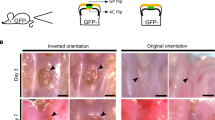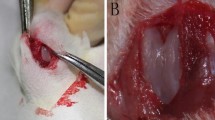Summary
Resting cartilages taken from 2-day-old mouse ribs were transplanted into spleens in order to carry out morphological investigations of the life cycles of their chondrocytes. The explants were isografted for periods of up to 60 days and examined at light and electron microscopic levels, using von Kossa's reaction or osmium-potassium ferrocyanide (OPF) fixation. By day 3 after transplantation, resting cartilage containing immature chondrocytes was well adapted to splenic tissue and by 7 days after transplantation these chondrocytes had changed into early hypertrophic chondrocytes containing large vacuoles, glycogen aggregates and abundant secretory organelles. It was also demonstrated by von Kossa's reaction that the initial calcification occurred in the territorial matrix during this period. In spite of the hypertrophic chondrocytes in the central zone being surrounded by an extensively calcified matrix during days 14–21 after transplantation, these cells had well-preserved organized organelles, except that Golgi-associated elements and endoplasmic reticulum revealed a tendency toward degenerative changes. With increased duration of the grafting period, from 30–60 days, the calcification zone progressed gradually, and the number of hypertrophic chondrocytes embedded in the calcified matrix decreased considerably. By day 60, degenerating hypertrophic chondrocytes of two types were distinguished: flattened cells containing large vacuoles, poorly developed Golgi apparatuses, and rough endoplasmic reticulum; and shrunken dark cells displaying terminal hypertrophy. During the present study, we observed no vascular invasion into the calcified matrix, or appearance of bone-related cells, and the morphological changes from the resting chondrocytes to cellular hypertrophy accompanied by the formation of a calcified matrix were observed at day 60. These findings indicate that resting cartilage cells of the mouse have the capacity for terminal differentiation when transplanted into the spleen.
Similar content being viewed by others
References
Alcock NW (1972) Calcification of cartilage. Clin Orthop 86:287–311
Anderson CE, Parker J (1966) Invasion and resorption in enchondral ossification: an electron microscopic study. J Bone Joint Surg 48-A:899–914
Bonucci E (1967) Fine structure of early cartilage calcification. J Ultrastruct Res 20:33–50
Bonucci E (1969) Further investigation on the organic/inorganic relationships in calcifying cartilage. Calcif Tissue Res 3:38–54
Bonucci E, Cuicchio M, Dearden LC (1974) Investigations of ageing in costal and tracheal cartilage of rats. Z Zellforsch Mikrosk Anat 147:505–527
Brighton CT, Sugioka Y, Hunt RM (1973) Cytoplasmic structures of epiphyseal plate chondrocytes: quantitative evaluation using electron micrographs of rat costochondral junctions with special reference to the fate of hypertrophic cells. J Bone Joint Surg 55-A:771–783
Bruckner P, Horler I, Mendler M, Houze Y, Winterhalter KH, Eich-Bender SG, Spycher MA (1989) Induction and prevention of chondrocyte hypertrophy in culture. J Cell Biol 109:2537–2545
Buckwalter JA (1983) Proteoglycan structure in calcifying cartilage. Clin Orthop 172:207–228
Campo RD, Phillips SJ (1973) Electron microscopic visualization of proteoglycans and collagen in bovine costal cartilage. Calcif Tissue Res 13:83–92
Campo RD, Romano JE (1986) Changes in cartilage proteoglycans associated with calcification. Calcif Tissue Int 39:175–184
Dearden LC, Bonucci E, Cuicchio M (1974) An investigation of ageing in human costal cartilage. Cell Tissue Res 152:305–337
Dearden LC, Mosier Jr HD, Espinosa T (1978) Cortisone induced alterations of costal cartilage in single and in parabiosed rats. Cell Tissue Res 189:67–89
Eggli PS, Herrmann W, Hunziker EB, Schenk RK (1985) Matrix compartments in the growth plate of the proximal tibia of rats. Anat Rec 211:246–257
Farnum CE, Wilsman NJ (1983) Pericellular matrix of growth plate chondrocytes:a study using postfixation with osmium-ferrocyanide. J Histochem Cytochem 31:765–775
Farnum CE, Wilsman NJ (1987) Morphologic stages of the terminal hypertrophic chondrocyte of growth plate cartilage. Anat Rec 219:221–232
Farnum CE, Wilsman NJ (1989) Condensation of hypertrophic chondrocytes at the chondro-osseous junction of growth plate cartilage in yucatan swine: relationship to long bone growth. Am J Anat 186:346–358
Holtrop ME (1972) The ultrastructure of the epiphyseal plate. II. The hypertrophic chondrocyte. Calcif Tissue Res 9:140–151
Howell DS, Marquez Pita JF, Madruga JE (1968) Partition of calcium, phosphate, and protein in the fluid phase aspirated at calcifying sites in epiphyseal cartilage. J Clin Invest 47:1121–1132
Ishizeki K, Fujiwara N, Sakakura Y, Nawa T (1987) The development of mandibular molar tooth germs isografted in the mouse spleen. Arch Oral Biol 32:695–704
Ishizeki K, Fujuwara N, Sugawara M, Nawa T (1990a) Endochondral calcification by hypertrophic chondrocytes in the Meckel's cartilage grafted into the isogenic mouse spleen. Arch Histol Cytol 53:187–192
Ishizeki K, Nawa T, Sugawara M (1990b) Calcification capacity of dental papilla mesenchymal cells transplanted in the isogenic mouse spleen. Anat Rec 226:279–287
Iwamoto M, Sato K, Nakashima K, Shimazu A, Kato Y (1989) Hypertrophy and calcification of rabbit permanent chondrocytes in pelleted cultures:synthesis of alkaline phosphatase and 1,25-dihydroxycholecalciferol receptor. Dev Biol 136:500–507
Jee WSS (1988) The Skeletal tissue. In: Weiss L (ed) Cell and tissue biology: a textbook of histology, 6th edn. Urban & Schwarzenberg, München, pp 212–254
Jibril AO (1967) Proteolytic degradation of ossifying cartilage matrix and the removal of acid mucopolysaccharides prior to bone formation. Biochem Biophys Acta 136:162–165
Kato Y, Sato K, Shimazu A, Iwamoto M (1989) Chondrocyte terminal differentiation and calcification: site-specific regulation (in Japanese). Tissue culture 15:390–394
Marchi F, Luder HU, Leblond CP (1991) Changes in cells' secretory organelles and extracellular matrix during endochondral ossification in the mandibular condyle of the growing rat. Am J Anat 190:41–73
Pacifici M, Golden E, Adams SL, Shapiro IM (1991) Cell hypertrophy and type X collagen synthesis in cultured articular chondrocytes. Exp Cell Res 192:266–270
Plank VJ, Rychlo (1952) Eine Schnellentkalkungsmethode. Zentralbl Allg Pathol 89:252–254
Poole AR, Matsui Y, Hinek A, Lee ER (1989) Cartilage macromolecules and the calcification of cartilage matrix. Anat Rec 224:167–179
Richman M, Diewert M (1988) The fate of Meckel's cartilage chondrocytes in ocular culture. Dev Biol 129:48–60
Schenk RK, Olah AJ, Herrmann W (1984) Preparation of calcified tissues for light microscopy. In: Dickson GR (ed) Methods of calcified tissue preparation. Elsevier, Amsterdam, pp 1–56
Shimomura Y, Frederick H, Wezeman FH, Ray RD (1973) The growth cartilage plate of the rat rib: cellular differentiation. Clin Orthop 90:246–254
Shimomura Y, Yoneda T, Suzuki F (1975) Osteogenesis by chondrocytes from growth cartilage of rat rib. Calcif Tissue Res 19:179–187
Silbermann M, Lewinson D, Gonen H (1983) In vitro transformation of chondroprogenitor cells into osteoblasts and the formation of new membrane bone. Anat Rec 206:373–383
Solursh M, Jensen KL, Reiter RS, Schmid TM, Linsenmayer TF (1986) Environmental regulation of type X collagen production by cultures of limb mesenchyme, mesectoderm, and sternal chondrocytes. Dev Biol 117:90–101
Suzuki F (1982) Hormonal effects on expression of the differentiated phenotypes of chondrocytes in culture (in Japanese). Taisha 19:729–736
Suzuki F, Yoneda T, Shimomura Y (1976) Calcitonin and parathyroid hormone stimulation of acid mucopolysaccharide synthesis in cultured chondrocytes isolated from growth cartilage. FEBS Lett 70:155–158
Suzuki F, Takase T, Takigawa M, Uchida A, Shimomura Y (1981) Simulation of the initial stage of endochondral ossification: in vitro sequential culture of growth cartilage cells and bone marrow cells. Proc Natl Acad Sci USA 78:2368–2372
Thyberg J, Nilsson S, Friberg U (1973) Electron microscopic studies on guinea pig rib cartilage: structural heterogeneity and effects of extraction with guanidine-HCL. Z Zellforsch Mikrosk Anat 146:83–102
Wezeman F, Childs GV (1982) Ultrastructural immunohistochemical localization of anti-invasion factor (AIF) in bone cartilage matrix. J Histochem Cytochem 30:524–531
Author information
Authors and Affiliations
Rights and permissions
About this article
Cite this article
Ishizeki, K., Kuroda, N. & Nawa, T. Morphological characteristics of the life cycle of resting cartilage cells in mouse rib investigated in intrasplenic isografts. Anat Embryol 185, 421–430 (1992). https://doi.org/10.1007/BF00174080
Accepted:
Issue Date:
DOI: https://doi.org/10.1007/BF00174080




